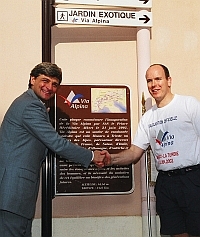And first, a bit of history…
|
1991: a political will
The Alpine Convention is signed. An international Treaty ratified by eight countries – Germany, Austria, Italy, Switzerland, Slovenia, Liechtenstein and Monaco – and the European Union, with the shared objective of ensuring sustainable development of the entire Alpine region.
1999: a visionary project
On the initiative of the Grande Traversée des Alpes (a French association specialising in walking tourism) a project for a great transalpine walking trail is launched both as a symbolic link between the eight countries who have signed up to the Alpine Convention, as the cultural expression of the Alpine region and to support the development of sustainable tourism. |
|  |
| 2000: a name, a brand
At the headquarters of the Rhône-Alpes region, in Lyon-Charbonnières, the representatives of the various States, regions and associations met to form an International Steering Committee (ISC). The christening of the project is complete: it will be called Via Alpina. The public launch is planned for summer 2002 so as to coincide with the International Year of the Mountains.
2001-2004: a working trail
Within the framework of the European programme Interreg Alpine Space, the trails are identified, marked and described and first multilingual promotional tools are created. Studies and pilot projects for improving the quality and the sustainability of tourist offers are carried out. In 2002 the Via Alpina is officially launched and recognised by the Environment ministers of the eight Alpine countries as contributing to the implementation of the Alpine Convention.
2005-2007: a « royal path » for discovery
Thanks to the new Interreg funding a second development phase is launched. In close collaboration with many local stakeholders, pilot projects are carried out to help visitors and walkers to discover the natural and cultural heritage of the Alpine region all the way along the trails and to develop the tourism services on offer. | | 2008-2013: responsible tourism
The eight partners concentrate on the maintenance of the routes and of the newly revamped website. The experiences of the Via Alpinists’ community are promoted and (thanks to the support of the Permanent Secretariat of the Alpine Convention and the Via Alpina Secretariat of the Principality of Monaco), travel fellowships are allocated to nine individual projects. The Via Alpina now holds a place among the best known long-distance hiking trails worldwide – in 2010 it is crowned World’s Best Hike by the American magazine “Backpacker” for its unique combination of nature, culture and infrastructure.
2014...: A new dimension
Upon request by all partners, the International Commission for the Protection of the Alps CIPRA takes over the international secretariat of the Via Alpina. With its over 60 years of experience in alpine conservation, its large network in politics, society and economy and its multilingualism, the umbrella organisation complements optimally the competences of the existing partners. The aim is to continue developing the tourist offer while also enriching it with the topics of sustainable development. Exciting ideas and projects shall thrive right and left of the long-distance trail. |